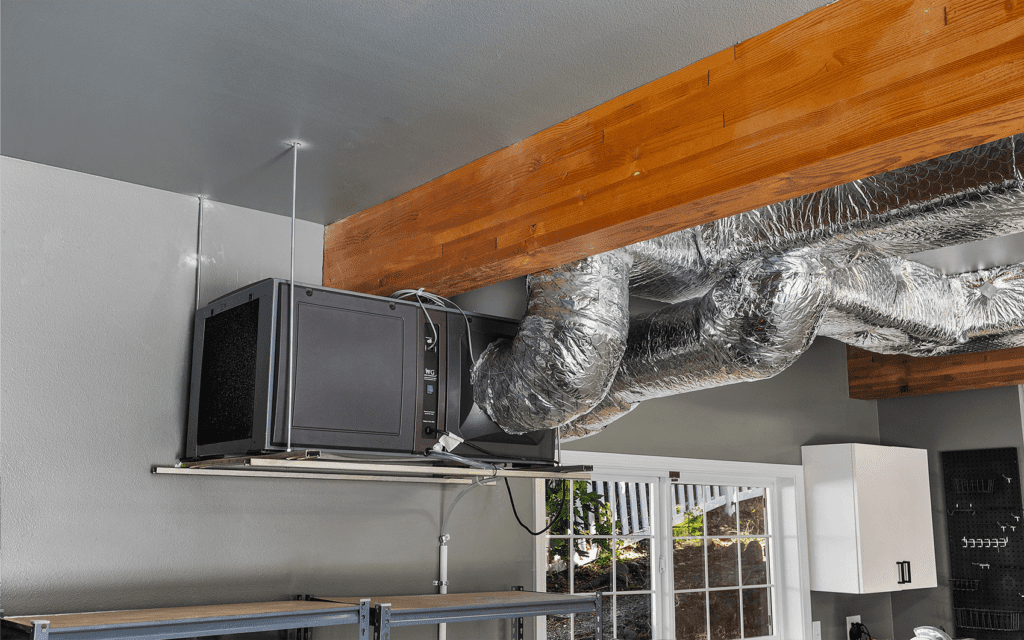
Even in its most primitive form, the main goal of any wine cellar is to keep its contents cool. Back in the old days, you simply put your bottles in a basement or crawlspace. There was no accounting for sudden changes in local climate, temperature and humidity; you just crossed your fingers and hoped for the best.
Fortunately, wine storage has come out of the basement, so to speak. Using the latest technology, cellars are now intelligent, actively managing their internal conditions around the clock. This means that a professional-grade storage space can now be located almost anywhere, even on the ocean floor.
At the heart of every modern cellar is the wine cellar cooling unit, which consists of a compressor and an evaporator component. A humidifier can also be added to keep the room at the perfect moisture level (–50-65% RH). Combined with a series of fans to circulate cool air, this system keeps the space’s temperature and relative humidity perfectly balanced, so your wine investment can age to its absolute peak.
Choosing the right cooling system can be overwhelming: it depends on everything from the size of your collection to your budget, and is often determined by the physical space available to you. There are as many options as there are scenarios, and no two solutions will be the same.
Need help narrowing things down? Here are the five main systems offered by Wine Guardian.
Though-The-Wall Wine Cellar Cooling Units
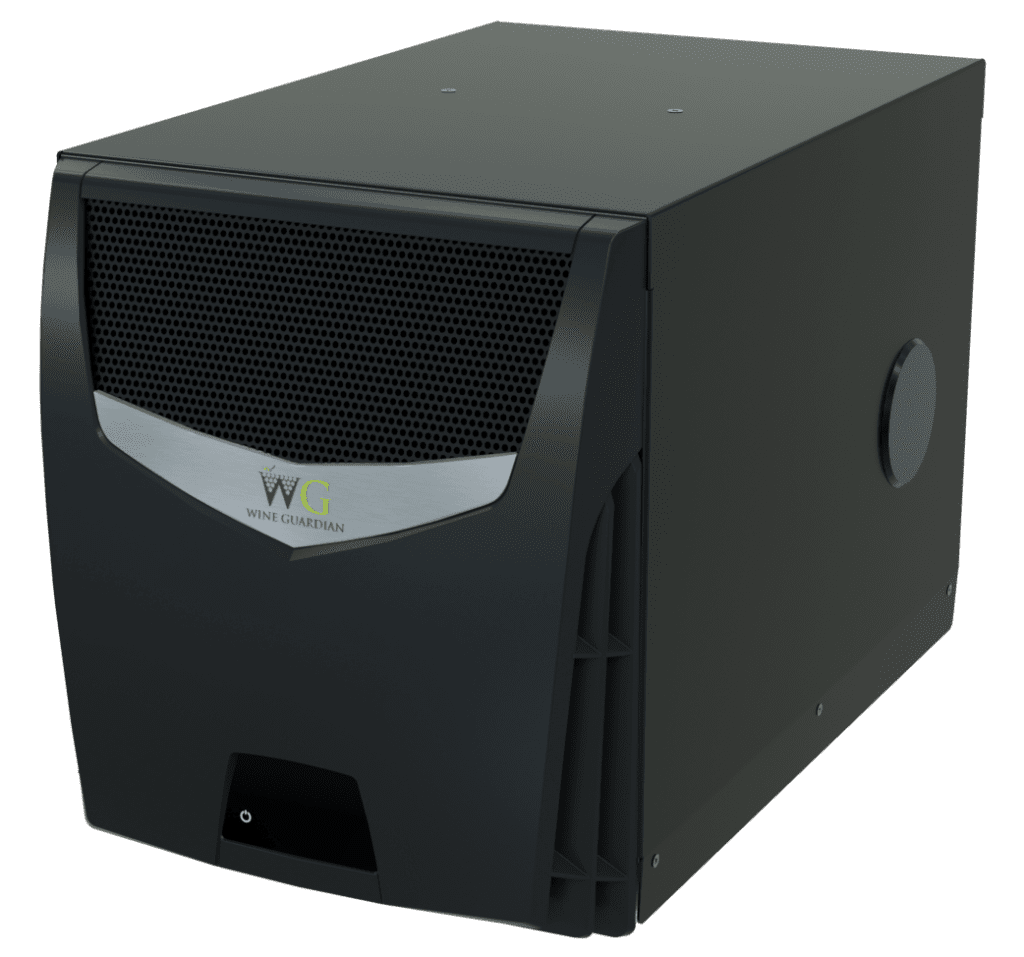
Through-the-wall (TTW) systems are the quickest, easiest and most affordable way to get your wine cellar up and running.
A TTW unit is entirely self-contained and mounts through a single opening in the wall of your cellar, similar to a traditional window air conditioner in a home. The unit vents its exhaust and condensation at the rear, which means you’ll need additional interior space on the other side of the wall.
Despite their seemingly basic nature, through-the-wall units are sleek and stylish, offering features like temperature and humidity monitoring, touchscreen controls, wireless remote operation, alarm capabilities and even an optional electric heater for operation in cold environments. Through-the-wall units can also be paired with a freestanding humidifier to create optimal storage conditions.
If simplicity and relative affordability are priorities, or if you prefer to do things yourself, this plug-and-play option may be perfect for you.
Ducted Wine Cellar Cooling Units
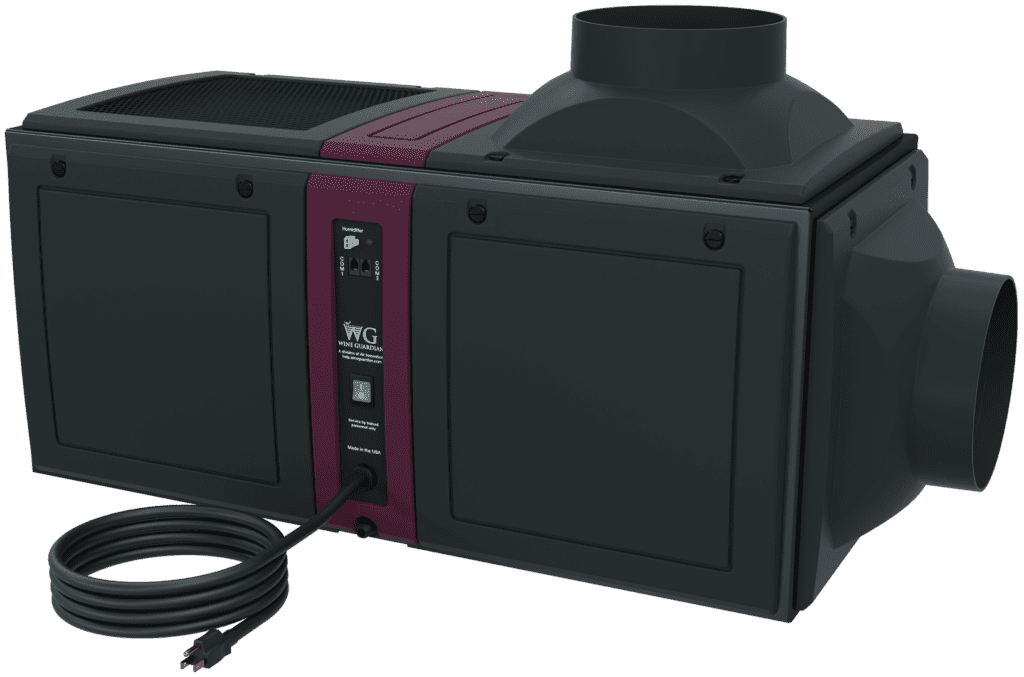
Like TTW units, ducted wine cellar cooling systems are completely self-contained, with the evaporator, fans, compressor, condenser and controls all in one unit. The unit is typically mounted outside the cellar (in an area like a mechanical room or crawlspace), and the air is carried into the cellar through flexible ductwork.
Because the system is situated independently of the cellar space, ducted units are quiet and unobtrusive; plus, they don’t physically take up any room inside the cellar, which means every inch of your space can be used to store wine.
To accommodate different-sized spaces/collections, Wine Guardian ducted units are offered at several capacities, ranging from 1,000 to 15,680 BTUs, making them robust enough for both residential and commercial wine spaces. Several option packages are available, from water-cooled capabilities to a humidifier add-on that connects directly to the side of the unit.
Installation of a ducted system is relatively easy, and since there isn’t any copper tubing or plumbing required, it can be installed by a basic contractor or handyperson without the assistance of a licensed contractor. This makes them a great choice for the collector with a modest budget.
Ducted Split Wine Cellar Cooling Units
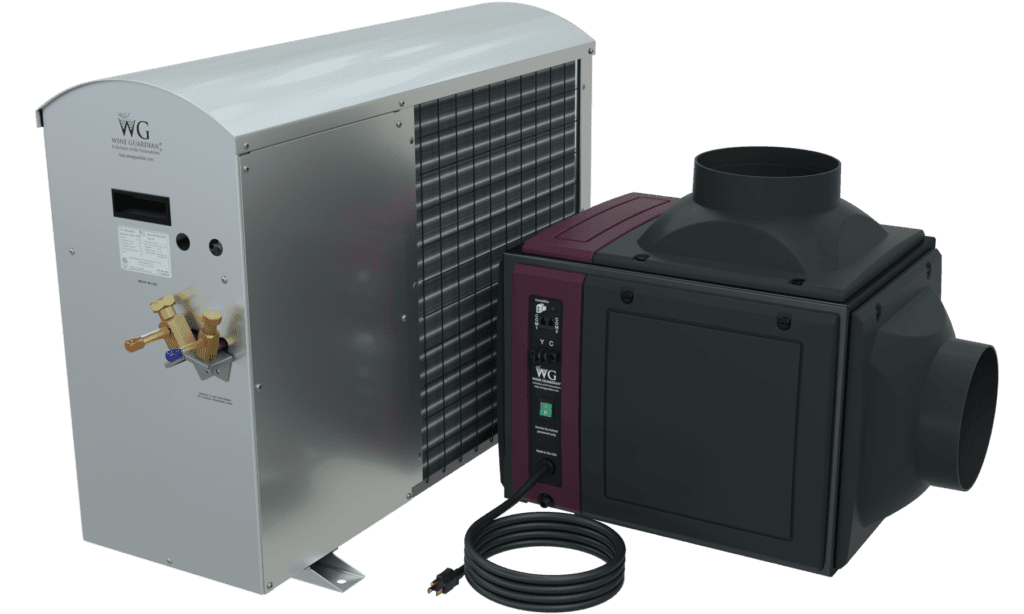
A ducted split wine cellar cooling system features independent evaporator and condenser units. By separating the units, the condenser can be placed outside the cellar or home, making for a smaller interior footprint. The evaporator is also located outside the cellar (in a crawlspace, utility room, etc.) and connected by ductwork. This makes this system great for scenarios where space is limited and several different layouts might be needed. The split configuration also enables an installer to run longer duct runs than that of a self-contained ducted system.
Since split systems are mounted outside the cellar, they create a space that is quiet, is vibration-free and maximizes the room for storage.
Wine Guardian ducted split wine cellar cooling systems can be controlled from any nearby location with a wireless controller. Wireless sensors placed inside the room can monitor your cellar day and night and correct for any fluctuations in temperature and humidity. A modular humidity unit can integrate directly with the evaporator to complete the package.
Split systems utilize copper refrigerant connections between the units and therefore require the assistance of a licensed contractor, making them a slightly more difficult installation. However, the flexibility and cooling capabilities these systems bring allow ductable split systems to handle larger and more complex wine cellar projects.
Ductless Split Wine Cooling Units
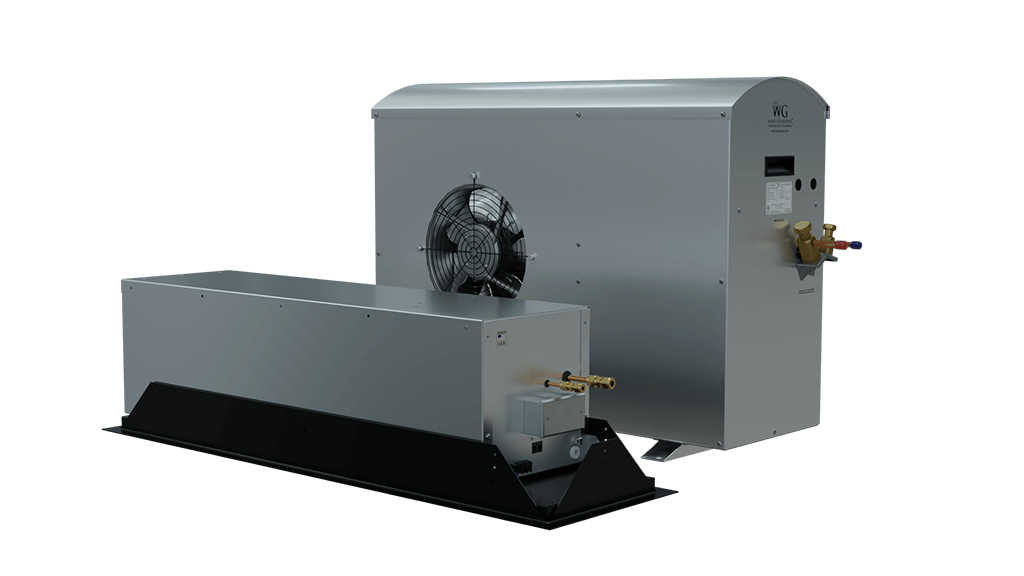
Where space is limited and running ductwork is not an option, a ductless split system is the way to go. A ductless split wine cooling system consists of separate condenser and evaporator units, but in this configuration, the evaporator is mounted directly into the ceiling or wall of the room. This option provides the power and flexibility of a split system without the ductwork.
Wine Guardian offers three styles of ductless split systems: wine wall, ceiling mounted and through-the-wall. These systems are great choices for almost any small- to mid-sized wine wall, display or room.
The wine wall cooling system mounts completely flush with a wine wall’s ceiling – creating a seamless integration with no bulky equipment visible. The ceiling-mounted system seamlessly integrates into the wine display’s ceiling without cutting joists – great for small rooms with limited wall space. And the through-the-wall ductless split system combines the installation simplicity of a traditional TTW system with the cooling abilities and flexibility of a split system.
Wine wall models also come standard with a serving temperature setting that cools wine down to temperatures optimal for consumption, making them perfect for restaurant wine displays or walls.
Cabinet Cooling Systems
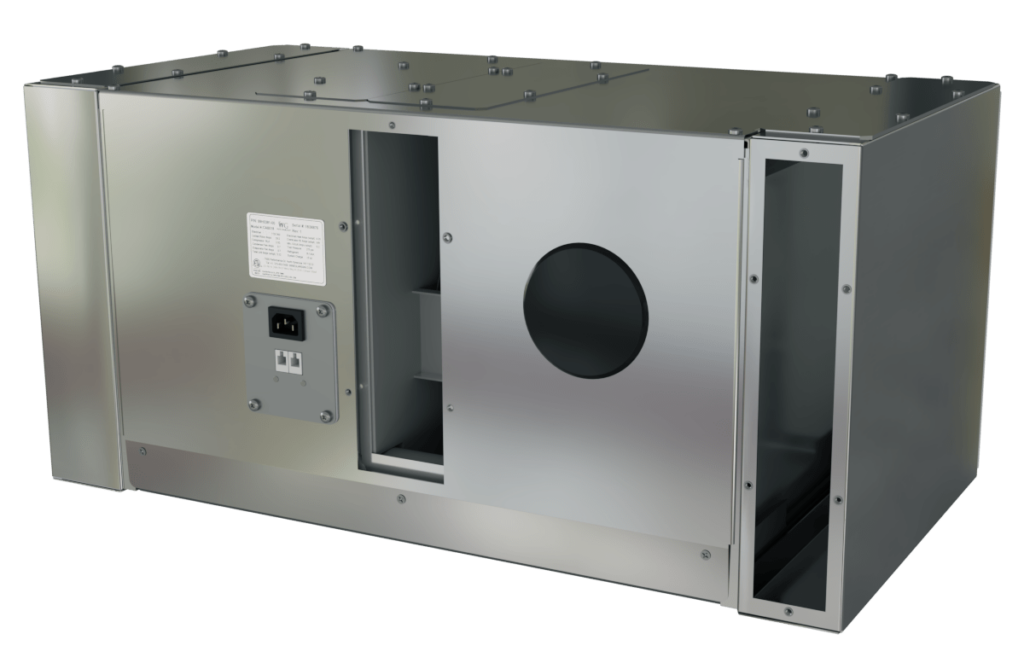
Wine cabinets are prefabricated enclosures that can be integrated into almost any existing space, even after construction. They can be countersunk into a wall, slid into a nook or corner of a room or finished as a stand-alone piece. However, many cabinets do not come with their own cooling system.
Wine Guardian Cabinet Cooling Systems are designed specifically to be installed into a wine cabinet. These compact, fully self-contained units require no ductwork or drain line connection and offer the flexibility to be installed either at the top or bottom of the cabinet. These systems are ideal for wine cabinet designers.
Our cabinet cooling system comes standard with a serving temperature option, which offers an extended temperature range from 42°F (6°C) to 64°F (18°C) so you can set each unit to serving temperature right off the rack. Combined with a slim footprint, these systems are a popular option for wine cabinets in restaurants, bars and hotels. It’s not uncommon for places to have several cabinets, each one adjusted to serve a different style of wine! The serving temperature option also allows the establishment to adjust the storage temperature as the seasons change, and as inventory rotates. Wine cabinets are typically less expensive to build than a traditional wine cellar. And because they’re compact, well-sealed and well-insulated, they’re roughly 60% more energy efficient. They’re a great option for compact locations where major construction or alterations are not possible and for people with small wine collections.
Wine Cellar Cooling Units: Which Will Work Best for You?
From the DIY-er with a modest collection, to a bustling restaurant in a major city, every fine wine collection warrants the best storage conditions possible, and it all begins with the cooling system. Wine Guardian offers dozens of options to work with/around any location, size and budget.
Whether you’re just getting started, looking to upgrade an existing space – or maybe even thinking about building another wine cellar – visit our distributor page to find a Wine Guardian dealer to help you with your project!

